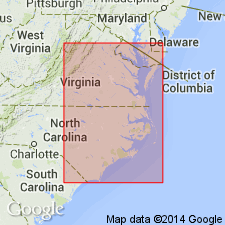
- Usage in publication:
-
- Trent marl
- Modifications:
-
- Named
- Dominant lithology:
-
- Marl
- Limestone
- AAPG geologic province:
-
- Atlantic Coast basin
Summary:
Trent formation, here named, is a distinctly calcareous formation (fine-grained calcareous marls or limestones) with little or no glauconite present. Along Neuse and Trent Rivers rests on Cretaceous strata belonging to Peedee formation, but farther west it lies on Precambrian crystalline rocks. Assigned to Eocene. Is unconformably overlain by Castle Hayne formation. [Later work by L.B. Kellum proved that the marl (marine) at Trent type locality is lower Miocene, and that the marl (also marine) at Castle Hayne type locality is upper Eocene (Jackson), and he restricted the names to accord, reporting a thickness of 0 to 100 ft for Trent marl. (See USGS Prof. Paper 143, 1926, also Jour. Geol, v. 33, p. 183-187, 1925).]
Source: GNU records (USGS DDS-6; Reston GNULEX).
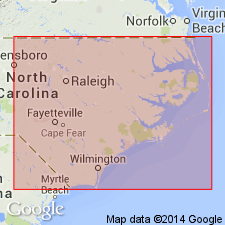
- Usage in publication:
-
- Trent marl
- Modifications:
-
- Revised
- Age modified
- AAPG geologic province:
-
- Atlantic Coast basin
Summary:
Kellum (1926, USGS Prof Paper 143) concluded that the Trent was of early Miocene age, separated from underlying Castle Hayne limestone of Jackson age by erosional unconformity. Most of Kellum's Trent species came from the vicinity of Silverdale, a locality not mentioned by Miller and which is about 17 mi from type locality along Trent River. Recent work has shown that Kellum's Trent (lower Miocene) is nonexistent and that units designated by Kellum as lower Miocene are in part of Castle Hayne age and in part of Yorktown age. Original Trent of Miller is here moved from middle Eocene to upper Eocene and included within the Castle Hayne although considered a distinctive facies of it.
Source: GNU records (USGS DDS-6; Reston GNULEX).
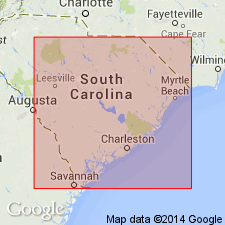
- Usage in publication:
-
- Trent Marl*
- Modifications:
-
- Age modified
- AAPG geologic province:
-
- Atlantic Coast basin
Summary:
Age changed from early Miocene to: late Oligocene and early Miocene.
Source: GNU records (USGS DDS-6; Reston GNULEX).
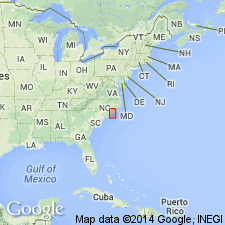
- Usage in publication:
-
- Trent Formation
- Modifications:
-
- Revised
- AAPG geologic province:
-
- Atlantic Coast basin
Summary:
Trent Formation is here revised. Lower part is assigned to New Bern Formation (upper Eocene). Type section along Trent River is modified. This unit is often confused with Belgrade and Silverdale Formations, which it underlies. Upper boundary is disconformity with Yorktown Formation. Age is modified to Oligocene only.
Source: GNU records (USGS DDS-6; Reston GNULEX).

- Usage in publication:
-
- Trent†
- Modifications:
-
- Abandoned
- AAPG geologic province:
-
- Atlantic Coast basin
Summary:
Trent Marl abandoned and its rocks now included in (ascending) middle Eocene Castle Hayne Formation (revised) with its New Hanover, Comfort, and Spring Garden Members (all new names); middle and upper Oligocene River Bend Formation (new name); and lower Miocene Belgrade Formation, with its Pollocksville and Haywood Landing Members (all new names).
Source: GNU records (USGS DDS-6; Reston GNULEX).
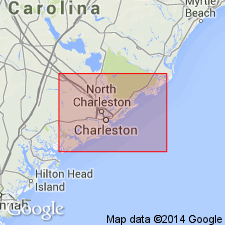
- Usage in publication:
-
- Trent Formation
- Modifications:
-
- Age modified
- Overview
- AAPG geologic province:
-
- Atlantic Coast basin
Summary:
Trent Formation is equivalent to the lower River Bend Formation of Ward and others (1978). Unit is early Oligocene (Vicksburgian) and is representative of the calcareous nannofossil Zones NP21-22. The Trent unconformably underlies the late Oligocene Belgrade or Silverdale Formation as used in this report. River Bend Formation is not used in this report.
Source: GNU records (USGS DDS-6; Reston GNULEX).
For more information, please contact Nancy Stamm, Geologic Names Committee Secretary.
Asterisk (*) indicates published by U.S. Geological Survey authors.
"No current usage" (†) implies that a name has been abandoned or has fallen into disuse. Former usage and, if known, replacement name given in parentheses ( ).
Slash (/) indicates name conflicts with nomenclatural guidelines (CSN, 1933; ACSN, 1961, 1970; NACSN, 1983, 2005, 2021). May be explained within brackets ([ ]).

